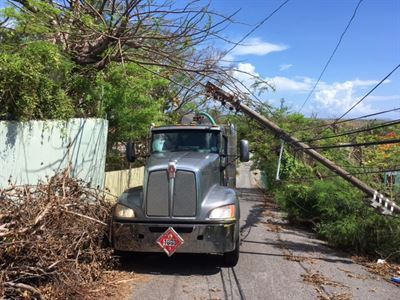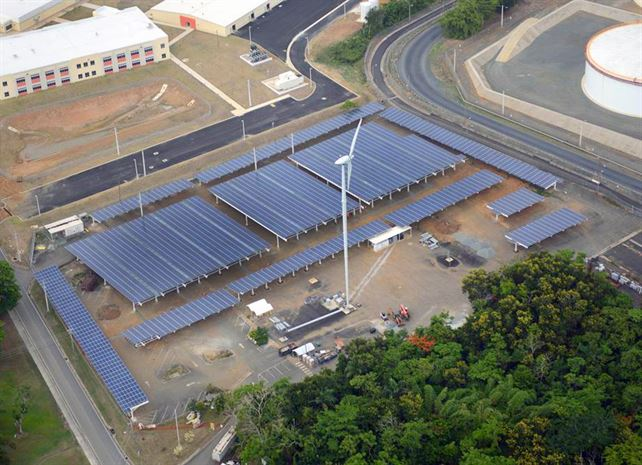Abigail Bradford
Policy Analyst
There is an opportunity right now to build a new type of grid in Puerto Rico – one that is more resilient to natural disasters, that fixes many of the problems of the old grid, and that is more environmentally and fiscally sustainable for the island’s residents.
Policy Analyst
It has been nearly eight weeks since Hurricane Maria hit Puerto Rico and over half of the island’s 3.4 million citizens still did not have power. This is the most severe power outage in U.S. history and is causing significant, widespread suffering in Puerto Rico. The lack of power is limiting residents’ access to clean drinking water, refrigeration, telephones, and necessary medicines – causing many to flee the island.
Restoring power has been slow, in part, because Puerto Rico’s entire grid was knocked offline by Maria – 80 percent of major transmission lines, 55 percent of transmission towers, tens of thousands of utility poles, and virtually all power lines were downed. Furthermore, the island’s major power generating facilities are located on the south side of the island, but most of its residents live on the north side. So, great lengths of transmission lines had to be repaired before power could be restored, which was made even more difficult by the mountainous, forested terrain of the island’s center.

Downed power lines in Puerto Rico following Hurricane Maria. Photo U.S. Department of Defense Open Domain.
Puerto Rico’s grid could be rebuilt to be more resilient to storms using hazard mitigation grants that are available under Section 406 of the Stafford Act. These grants could be used to merely rebuild Puerto Rico’s former grid using tougher materials – for instance, by replacing wood utility poles with concrete or steel ones. But, while these measures might make Puerto Rico’s grid somewhat more resilient to storms, they would not begin to address its many other problems.
The majority of Puerto Rico’s power plants are more than 40 years old and beyond their useful life. Most are also highly polluting and out of compliance with EPA emissions standards. Many of these power plants run on oil, which is a highly outdated practice – for comparison, less than 1 percent of electricity in the U.S. was generated with oil in 2016. Oil is very expensive to import to Puerto Rico and fluctuates greatly in price. This causes Puerto Ricans to pay twice as much for electricity as mainland U.S. customers on average and worsens the $9 billion debt of the Puerto Rico Electric Power Authority (PREPA), which controls Puerto Rico’s grid.
There is an opportunity right now to build a new type of grid in Puerto Rico – one that is more resilient to natural disasters, that fixes many of the problems of the old grid, and that is more environmentally and fiscally sustainable for the island’s residents.
Renewable energy sources, like rooftop and community solar panels, could be deployed all over the island and hooked up into microgrids, which do not rely on main power lines and, therefore, can keep providing power when those lines are taken out. This would be particularly helpful for Puerto Rico because their current power generators are located on the opposite side of the island from their population centers. This means that long lengths of transmission lines have to be repaired before power can be restored the island’s main cities, which has been a major cause of the current ongoing power outage.

Solar panels and a wind turbine at U.S. Army Garrison Fort Buchanan in Puerto Rico. Photo: U.S. Department of Defense open domain.
Renewable energy sources, which are dropping rapidly in price, could also reduce air pollution and protect Puerto Ricans and PREPA from the expensive, volatile costs of oil by replacing some of their dirty, aging power plants. Because Hurricane Maria was made worse by global warming, it also makes sense for Puerto Rico to rebuild with technologies that do not further exacerbate this crisis.
Tropical island states and nations are perfect candidates for renewable energy systems, especially since renewable energy allows for electricity to be produced locally, not imported at great cost. Small island nations the world over are considering transitioning to renewable energy – Hawaii has even set a goal of obtaining 100 percent of its electricity from renewable sources by 2045.
Restoring Puerto Ricans’ access to power soon is of the utmost importance. To prevent such widespread, long-lasting power outages in the future, officials should ensure that the reconstruction of Puerto Rico’s grid does not replicate the vulnerabilities and problems of the grid that was just destroyed. Rather, federal, state, and local officials should insist that Puerto Rico’s grid be rebuilt to position the island for a healthier, more stable and more prosperous future.
Policy Analyst
